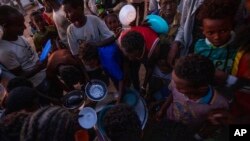Ethiopian forces are making gains in several towns near Tigray’s regional capital, one day after the government said it was beginning the "final phase" of an offensive in the northern region, the country’s news agency said Friday.
Lieutenant General Hassan Ibrahim said in a statement Friday that federal forces had captured Wikro "and will control Mekelle in a few days," according to the Reuters news agency.
There was no independent confirmation of the government claims. Phone and internet connections to the region have been down since the government’s military offensive began in early November.
The continued fighting came as Ethiopian Prime Minister Abiy Ahmed, following a meeting with African Union envoys, again ruled out negotiating with leaders of the Tigray region.
Abiy met with three AU envoys — former Presidents Ellen Johnson Sirleaf of Liberia, Joaquim Chissano of Mozambique and Kgalema Motlanthe of South Africa — in Addis Ababa on Friday.
A statement issued after the meeting said Abiy appreciated the commitment of the AU envoys “to the principle of African solutions to African problems.” He said his government was committed to the "protection and security of civilians" but made no mention of holding talks with the Tigray People’s Liberation Front.
Abiy, who won the Nobel Peace Prize last year for ending a two-decade standoff with Eritrea, announced a military offensive against the regional government in Tigray on November 4, calling it a response to an attack by Tigray forces.
Calls for negotiations have been growing as the conflict has spilled into neighboring Eritrea and threatens the stability of the wider Horn of Africa region.
Tigray officials have accused Eritrean troops of entering the conflict on the side of Abiy's government in Ethiopia. Eritrean officials deny any involvement.
The French news agency AFP, citing diplomats, reported that Tigrayan forces had fired at least one rocket toward neighboring Eritrea on Friday, the second such attack since the conflict broke out.
Eritrea has long been at odds with the TPLF, experts said, and they fear it could be drawn into the conflict between the TPLF and Ethiopia’s federal government.
Thousands of people are believed to have been killed since Abiy sent the national defense force into Tigray after accusing local forces there of attacking a military base.
More than 43,000 refugees have fled to Sudan.
Disaster feared
The International Rescue Committee said Friday that it was extremely concerned about an impending humanitarian disaster, noting that a half-million people live in the Tigrayan regional capital of Mekelle.
George Readings, IRC lead crisis analyst, said that “500,000 people are at risk as violence in Mekelle escalates.”
U.N. Secretary-General Antonio Guterres stressed Friday the need to ensure the protection of civilians, human rights and aid access, according to U.N. spokesman Farhan Haq.
A Vatican statement Friday said Pope Francis renewed a call for an end to the conflict and for political dialogue to resolve it. The pope appealed to both sides for the protection of civilians.











